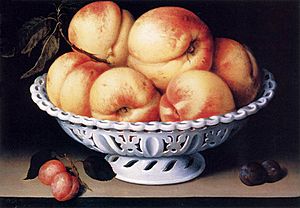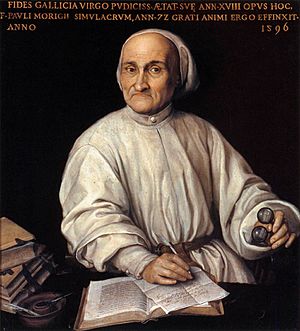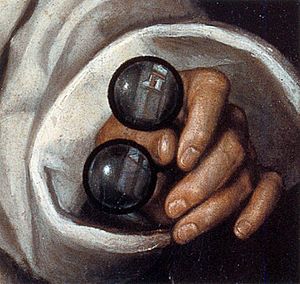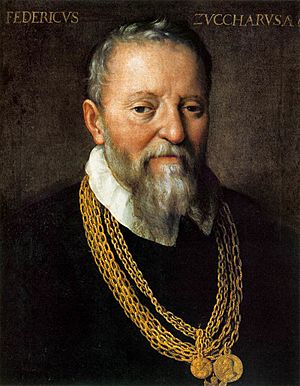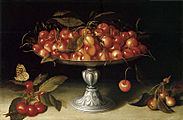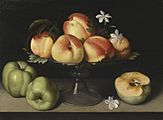Fede Galizia facts for kids
Fede Galizia (born around 1578, died around 1630) was an Italian artist from the Renaissance period. She painted many different things, like still lifes (pictures of objects), portraits (pictures of people), and religious scenes. She is especially famous for her still lifes of fruit. She was one of the very first artists in Europe to focus on this type of painting.
You might not know her as well as other famous female artists like Angelica Kauffman or Élisabeth Vigée Le Brun. This is partly because she didn't work for kings, queens, or very rich noble families.
Contents
Her Life
Fede Galizia was born in Milan, Italy, in 1578. Her father, Nunzio Galizia, was also a painter, specializing in tiny, detailed pictures called miniatures. Fede (her name means "faith") learned how to paint from him.
By the time she was twelve years old, she was already a very skilled artist. A painter and art expert named Gian Paolo Lomazzo, who was a friend of her father, wrote about her. He said that Fede was dedicated to copying "the most extraordinary of our art." By her late teenage years, she was known internationally for her art.
When she was young, Galizia was already a well-known portrait painter. She received many commissions (requests for paintings). Her father might have been inspired to train her by the example of Sofonisba Anguissola, another famous female painter. Galizia's father was a miniaturist, which might explain her amazing attention to detail in her portraits. She was very good at painting jewels and clothing, which made her a popular portrait artist.
She also often painted religious and everyday scenes. Several of her paintings show the story of Judith and Holofernes, which was a popular topic at the time. One of her earliest paintings on this theme was Judith with the Head of Holofernes from 1596. This painting is now in the Ringling Museum of Art in Sarasota, Florida. She also created small miniature paintings and large altarpieces for churches.
Fede Galizia never married or had children. She left her belongings to her cousin, Anna Galizia, and her nephew, Carlo Henrico. She made her will on June 21, 1630. It is believed she died shortly after from the plague in Milan.
Her Art Style
Galizia's painting style came from the realistic traditions of the Italian Renaissance. She painted things in a very lifelike way. You can see her great skill in her portrait of Paolo Morigia. He was a scholar, writer, and historian, and one of her first supporters. Her Portrait of Paolo Morigia (1596) shows him writing a poem about the very picture Galizia was painting. She also received requests to paint altarpieces for churches in Milan, like the Noli me tangere (1616).
When she wasn't painting portraits, Galizia mostly focused on still lifes. She was a pioneer in this type of art and is best remembered for it. Even though not many writings from her time mention her still life paintings, most of her surviving works are still lifes. Out of 63 works identified as hers, 44 are still lifes. Her only known signed still life, made in 1602, is the first dated still life by an Italian artist. However, her paintings didn't get the recognition they deserved until the 20th century.
Galizia's style was similar to the mannerism art movement of the late 1500s. This style was popular in Mantua and known internationally. Galizia’s still lifes are some of the earliest examples of this new art type. Women artists later became very good at still life painting, partly because they were not allowed to paint other subjects.
Galizia’s still lifes are more detailed and have brighter colors than her father's works. Most of her still lifes show fruit in simple, front-facing arrangements. Often, there is a basket or bowl filled with one type of fruit, like peaches or pears. A few pieces of fruit, sometimes sliced, are scattered around the base of the bowl.
Many of her still lifes also included fresh flowers or other fruits placed on a counter. This created a nice contrast and showed the size of the objects, as seen in her work Still-life with Peaches and a Porcelain and a Bowl. Galizia's work was influenced by paintings like Caravaggio's Basket of Fruit. She preferred a simple style, unlike some other artists who used more elaborate designs. Her style was similar to the later still life paintings of Francisco de Zurbarán.
Galizia’s paintings were full of detail and perfectly balanced. Her skill with shadows, light, and textures was amazing for her time. She was especially good at making her paintings feel inviting. Her compositions were not crowded. It looks as if you could reach out and touch the fruit, pick it up, and take it from the painting without messing up the rest of the artwork. Her graceful arrangements felt natural and artistic.
Her Portrait of Paolo Morigia (1596) was painted when Galizia was only eighteen. Every part of the person is painted with great detail. Galizia used mimesis (imitating reality) when painting Morigia’s glasses. The reflection in the lenses shows the room Morigia is sitting in, making the painting seem even more real.
Galizia is known as a pioneer in still life painting in Europe. We don't know exactly how many paintings Galizia created. Many works that might have been hers were instead given to a male artist named Panfilo Nuvolone, who was greatly inspired by Galizia. She may also have inspired other artists like Francesco Codino and the Baroque still life painter Giovanna Garzoni.
Gallery
See also
 In Spanish: Fede Galizia para niños
In Spanish: Fede Galizia para niños


